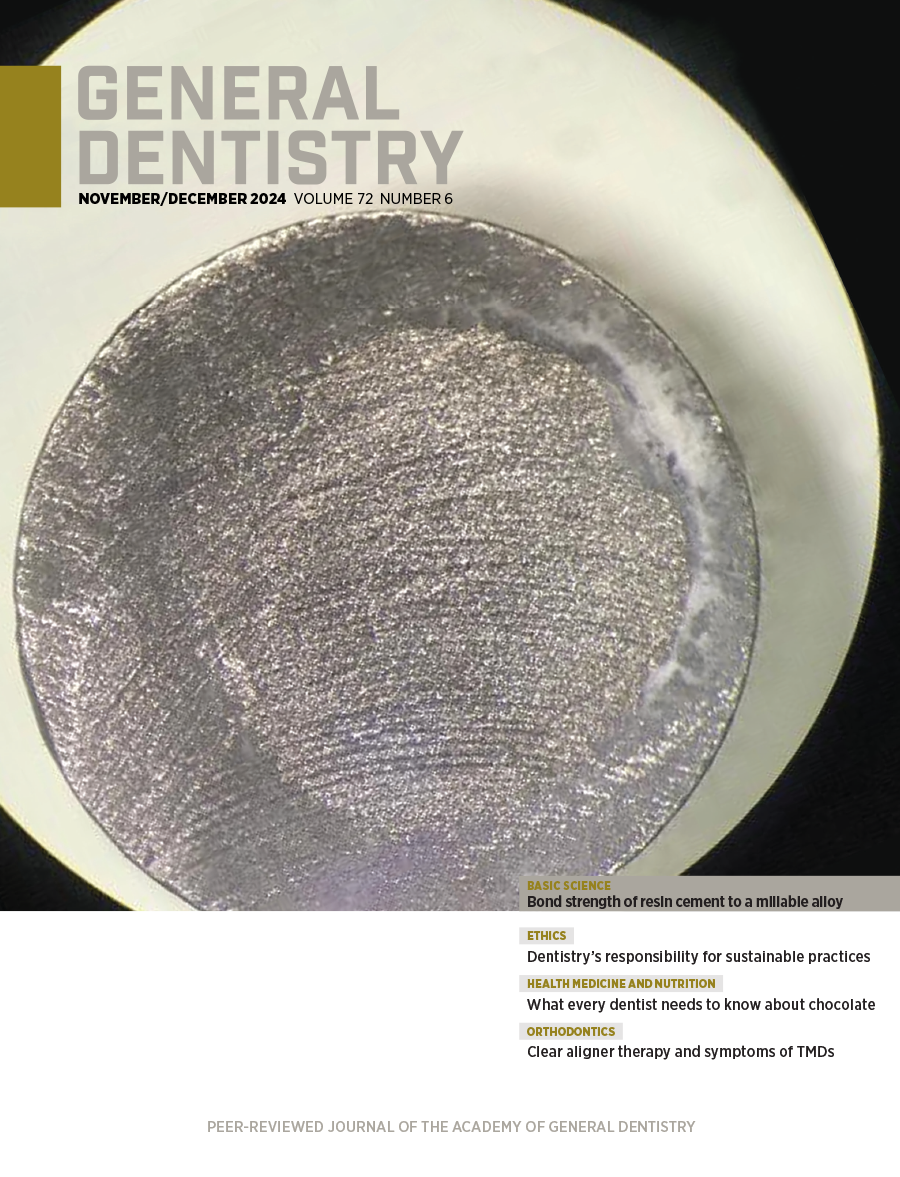-
SELF-INSTRUCTION
Basic Science
Evaluation of single-step self-etching ceramic primer and zirconia primer for bonding to zirconia-reinforced lithium silicate ceramic
Alfredo Estevam Llerena Icochea
Constantino Fernandes-Neto
Aliny Bisaia
Rafael Francisco Lia Mondelli
Fabio Antonio Piola Rizzante
Adilson Yoshio Furuse
This study evaluated the influence of simplified ceramic surface treatments on the microshear bond strength of 2 resin cements, Monobond Etch & Prime (MEP) and Signum Zirconia Bond (SZB), to a zirconia-reinforced lithium silicate (ZLS) material. The results indicated that the ammonium polyfluoride–based MEP may be used as a substitute for surface treatment with hydrofluoric acid and silane, but the use of the zirconia primer SZB alone is not advised for bonding to a ZLS ceramic.
2024 November/December; 72(6):20-24.
Full Article (PDF)
Self-Instruction Exercise No. GD536
-
Basic Science
Shear bond strength of resin cement to a CAD/CAM millable alloy subjected to various surface treatments
Mina Mohaghegh
Maryam Firouzmandi
Melika Hadadi
This study assessed the effect of different surface treatments on the shear bond strength between a resin cement and a millable cobalt-chromium alloy. Surface roughening procedures—either sandblasting or acid etching of the alloy surface—significantly improved the shear bond strength of resin cement to milled alloy surfaces, while the use of metal primer between the alloy surface and resin cement did not.
2024 November/December; 72(6):27-32.
Full Article (PDF)
-
Oral Medicine, Oral Diagnosis, Oral Pathology
Pathologic jaw lesions associated with impacted teeth
Saede Atarbashi-Moghadam
Hosna Emamipour
Yaser Safi
Mitra Ghazizadeh Ahsaie
Evaluation of the histopathologic diagnoses and radiographic characteristics of lesions associated with impacted teeth revealed that 64.6% of the lesions were dentigerous cysts (DCs) and 18.5% were odontogenic keratocysts. Lesions larger than 2.0 cm were 5.5 times more likely than smaller lesions to be diagnosed as non-DC lesions. Tumors were significantly more frequent in patients aged 18 years or younger, while cysts were more frequent in individuals older than 18 years.
2024 November/December; 72(6):33-37.
Full Article (PDF)
-
SELF-INSTRUCTION
Fixed Prosthodontics
Comparison of flexural strength, marginal gap, and internal fit of milled and 3D-printed crown materials
Matthew Firestone
Eric Hu
Robert Masterson
Gen Paek
Christopher Raimondi
Wen Lien
This study compared flexural strength, Weibull reliability, and internal fit among milled vs 3D-printed definitive and provisional materials. Milled specimens showed significantly higher flexural strength than 3D-printed specimens, while the marginal gap and internal fit of milled and 3D-printed crowns were comparable. All mean marginal gap values were within a clinically acceptable limit of less than 120 μm.
2024 November/December; 72(6):38-45.
Full Article (PDF)
Self-Instruction Exercise No. GD537
-
SELF-INSTRUCTION
Orthodontics
Clear aligner therapy and symptoms of temporomandibular disorders: a case report
Lina Sharab
Aqib Shafi
Bushra Butul
Jeffrey P. Okeson
Dental providers must consider the potential contributory role of clear aligner therapy in temporomandibular disorders (TMDs) in patients who adapt poorly to occlusal changes. This case report presents the case of a 56-year-old woman who developed symptoms of TMD pain during aligner therapy. The patient was educated on TMDs, and the treatment protocol was adjusted to only nighttime aligner use, alleviating the patient’s TMD symptoms while she completed orthodontic treatment.
2024 November/December; 72(6):47-52.
Full Article (PDF)
Self-Instruction Exercise No. GD538
-
Oral Medicine, Oral Diagnosis, Oral Pathology
An unusual clinical and histopathologic presentation of a maxillofacial ameloblastoma: a literature review and case report
Pallavi Parashar
Salima Asifali Sawani
Clayton Davis
Camila Pacheco-Pereira
This article describes a case of maxillofacial ameloblastoma and discusses the difficulty of using the most recent World Health Organization classification (2022) to differentiate clinically between primary sinonasal ameloblastoma and gnathic ameloblastoma with sinonasal extension. The authors suggest that variants with extensive involvement of the sinonasal region and maxilla be classified with a clinical diagnosis of maxillofacial ameloblastoma, regardless of the tumor origin.
2024 November/December; 72(6):54-61.
Full Article (PDF)
-
Fixed Prosthodontics
Minimizing excess cement around implant restorations: an in vitro study of cementation techniques
Hayleen Moran
Nurit Bittner
The amount of excess cement that resulted from different cement application techniques was evaluated in terms of both the distance traveled below the finish line and weight. Based on the findings, the wall layer cementation technique, in which cement is brushed on the intaglio walls of the crown, is recommended to reduce excess cement around implant crowns.
2024 November/December; 72(6):62-67.
Full Article (PDF)
-
Health Medicine and Nutrition
What every dentist needs to know about chocolate
Emily M. D. Wieser
Jeffery B. Price
Christina L. Platia
Nasir Bashirelahi
This article reviews the general health benefits of chocolate consumption, focusing on its involvement with the oral microbiota, caries development, and biofilm control, and discusses the potential negative consequences of excess chocolate consumption.
2024 November/December; 72(6):68-71.
Full Article (PDF)
-
Implants
Surgical treatment of peri-implantitis via multiple decontamination procedures and a regenerative protocol: a case report with 6-year follow-up
Ísis de Fátima Balderrama
Guilherme José Pimentel Lopes de Oliveira
Nicolas Nicchio
Ana Carolina Monachini-Marcantonio
Elcio Marcantonio-Junior
A case report is presented to describe the treatment of peri-implantitis around a single implant that had been in function for 10 years in the mandibular left molar region. A combination of decontamination procedures, a guided bone regeneration protocol, and connective tissue grafting successfully promoted bone formation around the implant.
2024 November/December; 72(6):72-76.
Full Article (PDF)

